CHAPTER XV.
EOCENE FORMATIONS.
THE EOCENE STRATA, to which we have now come in this epitome of British geological history,
form the oldest members of the Tertiary or Cainozoic series. It ought, however, to be
remembered, that the terms Palozoic or Primary, Mesozoic or Secondary, and Cainozoic or
Tertiary, are mere terms of local convenience, unfit even for minor territories such as Europe,
as the notice of strata intermediate to the Chalk and Eocene beds shows at the end of last chapter.
I cannot enter on the details of this subject here. Readers must work it out for themselves, and
there is no lack of printed matter from which to do so.
The EOCENE ROCKS of England lie in two basins, those of London and Hampshire. Both are
surrounded and underlaid by the Chalk. The London basin extends westward from the mouth of
the estuary of the Thames to the neighbourhood of Marlborough, and northward till it is lost
beneath the drift of Suffolk and Norfolk. The north boundary of the Hampshii e basin runs from
Beachy Head to the neighbourhood of Salisbury and Dorchester. The Chalk Downs near Newport,
Isle of Wight, form its southern boundary. In both areas the Chalk and Tertiary strata are little
distnibed, except in the Isle of Wight and at Purbeck, where for a space they have been heaved
nearly on end. The Lower
[Eocene Basins. 237]
Eocene rocks lie sometimes on upper beds of Chalk, and sometimes on beds lower in the series.
They are, therefore, highly unconformable to each other, and this alone marks a great interval
of time, unrepresented in England by the deposition of strata. The subject is evidently connected
with the nearly total break in succession of evident species between the Cretaceous and Eocene
formations; for, great continental areas of Chalk were heaved above the sea and remained as dry
land for a period of time so long, that, when they were again submerged, the life of Cretaceous
times had mostly been remodelled by slow evolution, and newer forms, in time became the
legitimate successors of their long-buried ancestors.
When critically examined, it soon becomes evident that the strata of the basins mentioned above
were not originally deposited in two distinct basin-shaped hollows, but that they were once
united, and formed one great area of Eocene age. Long after, a disturbance of the Secondary and
Lower Tertiary strata took place, which threw them into broad anticlina.1 and synclinal curves.
One long and broad anticlinal curve passes along the Wealden area from east to west, and still
further on through part of the Chalk. South of this we find the synclinal curve of the Hampshire
basin, bounded on the south by the Cretaceous strata of the Isles of Wight and Purbeck, and on
the north by the Chalk of the Salisbury, Winchester, and Brighton area, while north of the
Weald, the Eocene rocks of the London basin bounded by Chalk lie in a similar synclinal curve,
broad at its east or seaward end, and narrow at its western end towards Marlborough. When still
more closely examined, it is found that many beds of our Eocene strata were deposited in fresh
and in
[238 Eocene Series.]
brackish water, and others in the sea, and the conclusion to be drawn from this is, that they
largely consist of sediments that were thrown down at the mouth of a great river.
When we consider the original extension of these Eocene river beds, it is also remarkable that
they lie within the same general limits as those of the older fluviatile deposits of the Purbeck
and Wealden strata, as if, after a long interval, geological history were repeating itself in the
same area. In our own day, occupying part of the same district, we have yet a third estuary, that
of the Thames, small, but in some respects of more importance to the living world than many an
estuary of fifty times its size.
The various subdivisions of the English Eocene strata are given in the Table of British
Formations (p. 30), in which the classification of Professor Prestwich is used, which is also
that adopted by Sir Charles Lyell in his Manuals. As far, however, as England is concerned, it is
more philosophical, as it is certainly more convenient, to divide them into three groups, as
follows:
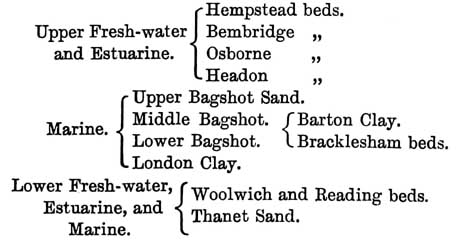
This classification has the merit of simplicity, being founded on circumstances relating to
variations in the physical geography of the time in our area, while the
[Thanet Sand. 239]
other seems to be more arbitrary, being founded on considerations of a purely palæontological
kind. It will at all events be most easy in this book to treat of the strata as consisting of a lower
fresh-water and estuarine, a middle marine, and an upper fresh-water and estuarine series.
The Thanet Sand, absent in the Isle of Wight, is so named by Professor Prestwich because it is
so well developed in the Isle of Thanet on the Thames. It lies at the base of the Eocene strata of
England, and consists of fine, light-coloured, quartzose sands, partly mixed with clayey matter.
It usually lies on a layer of Chalk flint, of an olive-green colour externally, and which probably
represents the effect of the waste of the carbonate of lime of the chalk which was carried away
in solution as bicarbonate, through the infiltration of rain-water after the deposition of the
sands, the associated silica having been concentrated and deposited in this band. These sands
range from the Isle of Thanet westward to the neighbourhood of London, varying from about 50
feet thick, in parts of Kent, to 4 feet, at East Horsley, where they disappear, being overlapped
by the Woolwich and Reading beds. They are quite unknown in the Hampshire basin.
The fossils of this subformation are entirely marine, and embrace about 70 known species.
Among these are a shark of the genus Lamna, Pisodus, and others; a Nautilus; Gasteropoda, such
as Fusus tuberosus, Scalaria Bowerbankii, Natica, Aporrhais, &c.; a considerable number of
Lamellibranchiata, such as Nucula Thanetania, &c.; Pholadomya Koninckii &c.; Corbula, Cardium, Ostrea Bellovacina, &c. &c.; Crustacea, Hoploparia, and Palcœocorystes; spines of
Echini (rare), a coral, a few Foraminifera, and land-plants. In the
[240 Thanet Sand.]
Paris basin, so celebrated for its Eocene strata, the Sables de Bracheux are the equivalents of
the Thanet Sand, in which the skull of a carnivorous quadruped (Arotocyom primœvus) was
found.
More than 20 species of shells found in the English Thanet Sand are also known in the Woolwich
and
FIG. 46.
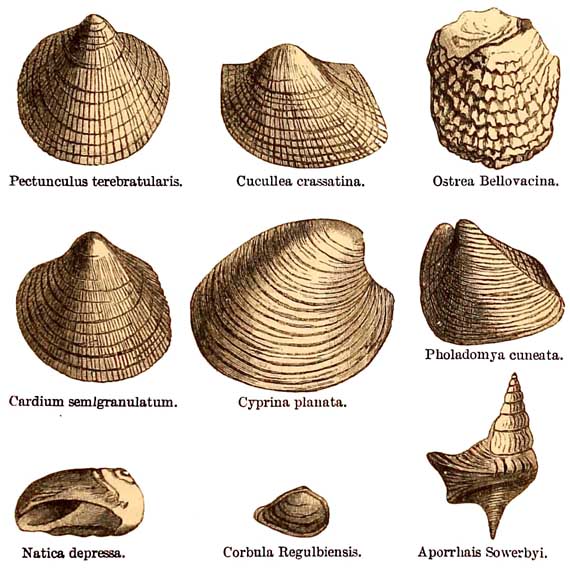
Groups of Fossils from the Thanet Sand
Reading beds, and in the London Clay, and Barton and Bracklesham beds. The Thanet Sands are,
indeed, so like those of the Woolwich and Reading beds, that, but for their position, it is
sometimes difficult to distinguish between them, and they were formerly
[241]
FIG. 47.
 Section across the Isle of Wight from High Down to Headon Hill, showing the arrangement of the
strata in Alum Bay. By H. W Bristow, F.R.S.
Section across the Isle of Wight from High Down to Headon Hill, showing the arrangement of the
strata in Alum Bay. By H. W Bristow, F.R.S.

[242 Woolwich and]
looked upon as a portion of the Woolwich and Reading series, which partly consists of a few
saltwater beds, interstratified with a preponderance of fresh-water deposits. Excepting that the
Thanet Sand is altogether marine, it is possible that it might have continued still to be classed
simply as one of the minor marine portions of the Woolwich and Reading series.
The Woolwich and Reading beds, formerly called the Plastic Clay (Argile plastique of the Paris
basin), overlie the Thanet Sand, and rest directly on the Chalk, when, as in the greater part of
the London basin, and in Hampshire and the Isle of Wight, the Thanet Sand is absent. They may
be broadly described as consisting of many wedge-shaped interstratifications of mottled clays,
light-grey sands, and pebble-beds, made of chalk flints, which are sometimes loose and
gravelly, and sometimes hardened into conglomerates. From west to east the strata vary from
15 to 90 feet thick in the London basin. In the Hampshire basin they are still less developed
(fig. 47), and the whole consists of mingled marine, estuarine, and often of purely freshwater
strata, marking the first obvious signs of the influx of a great river, formed by the drainage of
a continent, the result of the upheaval above the sea of large areas of Chalk and other older rocks
in what is now Britain and the nearest parts of France. There can be no doubt, however, that the
Thanet Sands are the result of the same set of conditions, only they were deposited further from
shore in a comparatively open sea.
More than 100 species of fossils are known in the Woolwich and Reading strata, including an
herbivorous mammal of the genus Coryphodon, allied to the modern tapirs of South America,
which live on the banks of the Amazons and other great rivers, also the bones of a bird,
[Reading Beds. 243]
turtles, and the scutes of a crocodile; several fish of the
genus Lamna (L. contortidens, &c.), Lepidosteus,
Lepidotus, and Myliobatis; marine Gasteropoda, such
as Cerithium funatum, &c.; Fusus latus, Hydrobia Parkinsoni, Melanopsis brevis, &c. : Natica, Neritina,
FIG. 48.
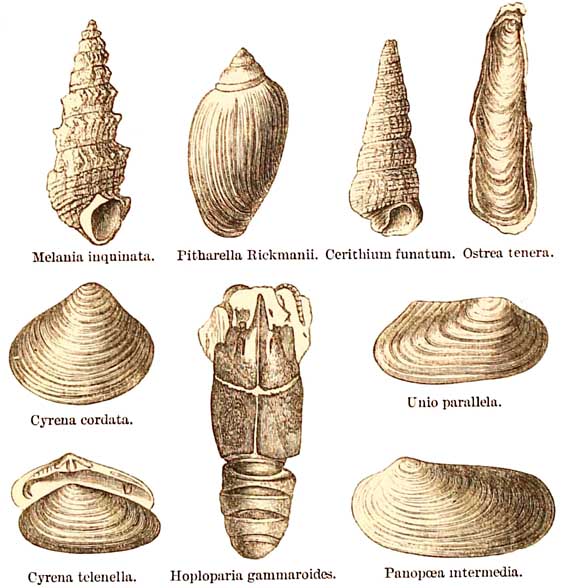 Group of Fossils from the Woolwich and Reading Beds.
Group of Fossils from the Woolwich and Reading Beds.
and others. Lamellibranchiata, not very numerous as genera and species, but plentiful as
individuals, occur both in the sands and clays, including species of Arca, Cardium, Corbula, Cyprina Morrisii, Cyrena cordata, &c., Modiola elegans, Ostrea edulina or Bellovacina,
[244 Oldhaven Beds.]
O. elegans, &c.; Pectunculus, Psammobia, &c.; Crustacea (Hoploparia gammaroides) and Foraminifera also occur.
A few land-plants have been found, as might be expected in estuarine strata, viz. Dryandroides Prestwichi, figs, laurels (L. Hookeri), Grevillia Heeri, and Robinia Readingensis; also great
numbers of freshwater shells in true fresh-water strata, such as Paludina lenta, &c.;
Planorbis lœvigatus, &c.; and several of the genera Cyrena (C. cordata, &c.) and Unio, together
with the small bivalve Entomostraca, Cypris and Cythere.
Taken as a whole, the estuarine, and especially the fresh-water character of so many of the
strata of this series, make the strongest impression on anyone engaged in mapping them.
The Oldhaven beds, formerly included by Mr. Prestwich in the basement bed of the London Clay,
lie between the above-named strata and the London Clay, and consist of fine sand containing
water-worn pebbles of flint. They are of inconsiderable thickness, but very constant in their
occurrence. With the rarest exceptions the fossils are marine; and they are numerous,
consisting to a great extent of the same molluscous genera as those found in the Eocene strata
below, with additions, and a proportion of the species are also found in the overlying London
Clay. Their chief importance in this sketch is, that the sand with water-worn pebbles seems to
indicate some oscillation of level, accompanied by stronger currents, in an estuary which
carried flintpebbles onward, toward the mouth of this old river.
The London Clay (fig. 47, p. 241), is a marine deposit, in the sense that the strata now forming
in the broad estuary of the Amazons is marine. It usually consists
[London clay. 245]
of brown and bluish-grey clay, with occasional bands of calcareous concretions
(septaria). In the London basin it varies in thickness from 50 feet in the extreme west, at
Newbury, to 480 feet in Essex. In the Isle of Wight, at Alum Bay, it is only 200 feet thick (fig.
47); in Whitecliff Bay, 295 feet; and at the west extremity of that basin, in Dorsetshire, it
dwindles away, being barely distinguishable except to well-accustomed eyes. The chief
fossiliferous locality in the Hampshire basin is at Bognor in Sussex. In the Isle of Wight fossils
are scarce in this formation. Round London they occur at Highgate, and in other places far to the
west. The Isle of Sheppey has long been famous for its fossils, being found there chiefly because
of the frequent landslips from the cliffy slopes that overlook the estuary of the Thames. The
plants have long been celebrated, consisting of various Palm-nuts, Nipadites ellipticus, and N.
umbonatus, and other fruits; Coniferæ, many leguminous plants, laurels, figs, junipers, and
plants of the citron tribe, are also common, all of extinct species.
Remains occur of birds allied
to the vulture (Lithornis vulturinus) and king-fisher (Halcyornis toliapicus),
and a small swimming-bird, described by Owen, with tooth-like serratures on
the bill; turtles and river tortoises are numerous of the genera Chelone
(breviceps, &c.), Emys (Conybeari, &c.), Platemys, and Trionyx;
also a crocodile (Crocodilus champsoides) and snakes (Palœophis toliapicus
and P. longus). Terrestrial mammals also occur — a Marsupial (Didelphis Colchesteri), a Bat, and Hyracotherium cuniculus; also Miolophus planiceps,
Pliolophus vulpiceps, and Coryphodon eocœnus, which are tapir-like animals,
in a distant way allied to the tapirs now found on the banks of South American
rivers.
[246 London Clay.]
Plants, birds, reptiles, and mammals all tell of the immediate neighbourhood of land, and the
marine fossils now to be mentioned seem in fact to have lived at the mouth of a great river.
FIG. 49.
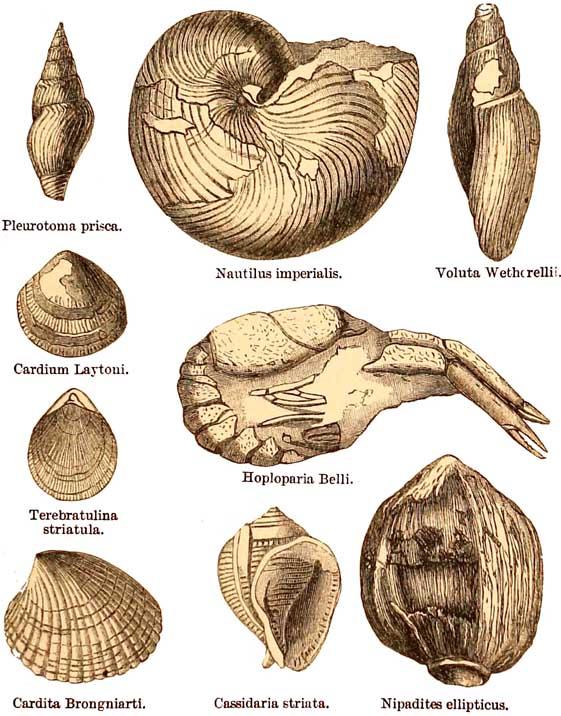
Group of Fossils from the London Clay.
Nearly 60 genera of fish have been noted from
the London Clay alone, including species of Lamna
[London clay. 247]
and many species of Rays (Myliobatis). Of the Cephalopoda, Nautilus (N. Sowerbyi, &c.) is
common, together with Cephalopods, Belemnosis plicata, Belosepia sepioidea, and Beloptera
Levesquei. Ammonites and Belemnites, genera common in the Cretaceous strata have
disappeared. Gasteropoda occur in vast profusion, the most prominent genera being Fusus (F.
regularis, F. lœviusculus, &c.), Murex (M. cristatus, M. coronatus, &c.), Pleurotoma (P.
Helix, P. Keelii, &c.), Voluta (V. nodosa, &c.), Pyrula (P. Smithii, &c.) Cyprœa (C.
oviformis), and Rostellaria (R. ampla, &c.). Lamellibranchiata, though common, are less
numerous, including among others the genera Pinna (affinis, &c.), Pholadomya (Dixoni,
&c.), Arca, Avicula, Pecten, Cardium, Cyprina, Nucula, &c. The Brachiopoda are only
represented by Lingula tenuis and Terebratulina striatula, and there are a few Polyzoa.
Crustacea are exceedingly numerous, especially crabs (Brachyura and Anomura), including the
genera Xanthopsis, Hoploparia, &c.; and of Entomostraca, Cythere is common of many species.
Among the Echinodermata we have Hemiaster Bowerbankii, &c.; Goniaster, Cidaris,
Astropecten Colei, &c.; Ophiura Wetherellii, and Pentacrinus, and there are also a few Corals.
Many of the fossils of the London Clay are found in other strata both above and below that
formation, but a larger proportion is common to the overlying than to the lower formations.
Looked at in a comprehensive way, an accurate observer cannot fail to be struck with the fact
that the assemblage of fossils found in the London Clay point in this direction, viz., that the
whole of these strata were deposited in the estuary of a great continental river comparable to
the Amazons and the Ganges. The Palm-nuts
[248 Bagshot and Bracklesham Beds,]
and the host of other plants help to prove it, and the remains of river tortoises, crocodiles,
snakes, marsupial, and several tapir-like mammals, all point in the same direction. The
estuarine conditions, begun during the deposition of the Woolwich and Reading beds, were still
going on when the London Clay was thrown down, with this difference, that by sinking of the
area, the estuary had become longer, wider, and deeper, but still remained connected with a vast
continent, through which the Eocene river flowed.
The Bagshot and Bracklesham
Sands and Clays, fig. 47, succeed the London Clay. These are well shown on
Bagshot Heath, and on the coast of Hampshire. On Bagshot Heath, they consist
of lightbrown and yellow sands, with beds of clay, which, in a rude way,
form the middle part of the strata, thus dividing them into Lower and Upper
Bagshot sands, the whole, where thickest, being about 300 feet thick. The
sands are very sparingly fossiliferous, but the clay, in places, contains
a few species. In the Hampshire basin, at Bracklesham and other places, the
lithological character of these strata is very inconstant, but they consist
of the following series of strata, which are partly quite local:
Upper Bagshot Sands, &c.
Barton Clay (quite local).
Bracklesham shells, sands, and clays.
Lower Bagshot Sands and Clays, with occasional lenticular beds of pipe-clay containing leaves,
&c.
These strata have yielded about 200 species of fossils, mostly distinct from those of the London
Clay. Many of the Gasteropoda have a tropical aspect, such as Cyprœa Bowerbankii, Murex
minax, and Conus diversiformis. Gasteropoda, of these and other genera, are exceedingly
numerous, viz., Pleurotoma, Voluta,
[and Barton Clay. 249]
Natica, Ancillaria, Turritella, &c., &c. A large
Oyster (O. picta), various Pectens, a great Cardita (C.
planicosta), Cardium, Cytherea, Solen, Sanguinolaria, &c.
are common in England in the Bracklesham series, and a foraminifer, Nummulites lœevigatus. In the same set of rocks there have also been found a serpent Palœophis T'yphœus,
20 feet in length, and P. porcatus; a turtle, Chelone trigoniceps; a crocodile, Gavialis Dixoni;
and a tapiroid mammal, Lophiodon minimus; and fish, including Sharks and Sword-fish. The
Bagshot Sands form the highest Eocene beds of the London basin. In the Hampshire basin,
however, there are many newer formations.
The Barton Clay, on the coast
west of Lymington in Hampshire, is quite a local deposit, and both on stratigraphical
and palæontological grounds is assumed to be the general equivalent of the
clays that lie between the Upper and Lower Bagshot Sands. It is especially
fossiliferous, containing a few fish, a crocodile (C. Hastingsiœ), and more
than 200 described species of marine shells. These have in general a tropical
character, as if in the course of time the climate of our area had become
warmer, due possibly to astronomical causes, which I need not here stay to
describe. Among them are large Nummulites, various large and small Volutas
(V. athleta, V. ambigua, V. luctatrix, &c.); Murex minax, Rostellaria
ampla, and others; Buccinum, Triton, Turritella, Natica, and many more. Numerous
Lamellibranchiate molluscs also occ including Oysters (O. flabellula, &c.); Chama squamosa, Pectunculus deletus, &c.; Arca duplicata, &c.; Cardium
porulosum, &c.; Cardita, Panopœa, Cytherea, Corbula, &c, &c.
Near Poole Harbour landplants occur in these strata in lenticular beds of
pipe-clay,
[250]
FIG. 50.
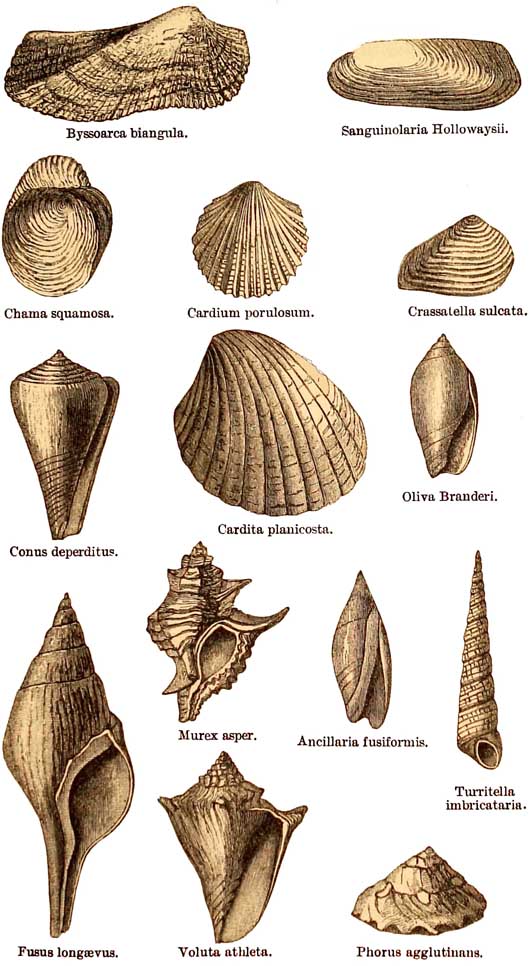
Group of Fossils from the Bracklesham and Barton Beds.
[Headon Hill Sands. 251]
such as Oaks, Yews, Cypress, Spindle-trees, Dryandra, Laurels, Limes, Figs, Sennas, &c., &c., but all of extinct species. In this assemblage of plants
we have ample evidence of the vicinity of land, and though modern crocodilia have no special
objection to saltwater in the mouths of the Ganges, yet they are not in the habit of pursuing
their game into the open ocean, aud we may therefore more than suspect, that even fhis part of
the Eocene series was deposited within the ocean mouth of a great river such as the Amazons.
The Bagshot series, including all the strata mentioned above, form the highest part of the Eocene
strata, which exclusively contain marine mollusca.
We now come to the undoubtedly Upper Freshwater and Estuarine deposits.
The Heacon Hill Sands (fig. 47), including the clays of Hordwell Cliffs, come next in succession.
These form the lowest part of the great fluvio-marine deposits, which constitute the remainder
of the Eocene rocks of Hampshire and the Isle of Wight, for none of these strata are found within
the area of the London basin. Some of the marine shells of Hordwell are common to the Barton
beds. Its marine strata contain sharks' teeth, Murex, Buccinum, Ancillaria, Voluta,
Marginella, &c., Oysters, Pectens, Corbula, Balanus, &c., Fusus porrectus, Oliva Branderi,
and Nummulites lœvigata. The brackish-water strata have yielded Cerithium mutabile, C.
cinctum, Potamomya plana, &c., and the fresh-water rocks contain Paludina lenta, Planorbis
euomphalus, Limnœa caudata, Cyclas, several species of Cyrena, Unio Solandri, Melania, &c.,
besides land-shells of the genus Helix, and of vegetable remains, two species of Carpolithes (a
conifer), and Chara Wrightii. In the Hordwell Cliffs and elsewhere,
[252 Osborne and Bembridge Beds.]
numerous reptiles have also been found, including two
serpents Palœryx depressus, and P. rhombifer, Turtles, and seven species of Trionyx; Crocodilus toliapicus, and Alligator Hantoniensis. Among the mammals of the same beds have
been found Palœotherium annectens, a three-toed animal somewhat like a tapir;
Anoplotherium commune, having affinities both with pigs and ruminants; Chœropotamus
Cuvieri, somewhat like the river-hog; Dichodon cuspidatus and Microchœerus erinaceus; also a
bird, Macrornis tanaupus.
The Osborne Beds (fig. 47) succeed the Headon series, and are well seen on the coast near
Osborne, and Nettlestone in the Isle of Wight. Different sections vary in lithological character,
but they may be generally described as consisting of sands and clays, from 60 to 80 feet thick,
containing fresh-water shells, such as Cyrena obovata, Achatina costellata, Limnœa longiscata,
Melania costata and excavata, Melanopsis brevis, Paludina lenta in great numbers, first
known in the Woolwich and Reading series, and P. globuloides, Planorbis euomphalus, and five
others, and a Unio. Entomostraca (Crustacea) also occur, viz., Candona Forbesii, Cythenidea
Mullerii, and Cythereis unisulcata, with fresh-water plants Chara Lyellii and C. medicagulina.
A land-shell, Helix occlusa, and a Cerithium are also found, the latter of which may have lived
in brackish water, but the general assemblage is entirely fluviatile.
The Bembridge Beds (fig. 47) overlie the Osborne series in the Isle of Wight, and 'spread over
the greater portion of the surface of the island which is occupied by Tertiary deposits.' They are
fluvio-marine, and consist at the base of soft cream-coloured fresh-water limestone,
sometimes 20 feet thick, overlaid by an
[253]
FIG. 51.

Group of Fossils from the Headon and Bembridge Beds.
[254 Hempstead Beds.]
Oyster band, which is succeeded by about 40 feet of marls. The limestone is a remarkable stratum,
containing numerous nuclei of Chara, fresh water shells, viz. Limnœa loqiscata, Paludina globuloides, Planorbis, Melania, and of land-shells, five species of Helix, Bulimus ellipticus,
Pupa perdentata, and Cyclotus cinctus. Above this bed is a characteristic oyster-band with
Ostrea Vectensis, and this is succeeded by marls in different bands highly charged with Paludlina
lenta, Limnœa longiscata, Bulimus, Melania, Unio, Cyrena semistriata, C. obovata, and other
fresh and brackish water shells. In the Bembridge beds there has also been found the
Anaplotheroid mammal Dichobune cervinum, and five species of Palœeotherium, viz. P. crassum, curtum, magnum (fig. 5l), medium, and minus; the nearest living analogues of which
may be said to be the tapirs of the South American rivers.
The Hempstead Beds form the uppermost portion of the British Eocene strata. The Bembridge
beds below pass gradually into them, and the fossils throughout the lower part of the Hempstead
series are in great measure identical with those of the Bembridge mans, containing Paludina
lenta in profusion, Planorbis obtusus, Limnœa, Cyrena semistriata, Unio, Melania, &c., and
at the very top is a marine band containing Corbula pisum, and Oysters. The mammalia
Hyracotherium leporinum and Hyopotamus bovinus and H. Vectianus (Suidæ) occur in these
strata. These Hempstead beds were first clearly described by Edward Forbes, who considered
them to be of Upper Eocene age. Sir Charles Lyell, however, following Mr. Pengelly, because of
certain land plants, considered these uppermost strata to be Lower Miocene. Plants afford a
more uncertain test of geological age than mollusca,
[Physical Geography. 255]
and in the genera of plants
alone, it would be as allowable to refer the Cretaceous flora of Aix-laChapelle
to the Miocene age, as it is to refer the Hempstead beds to that epoch. The
genera of mammalia, also of the Hempstead strata, are truly Eocene, for Hyopotamus
is found in the Headon series, and Hyracotherium in the London Clay. The
Hempstead beds, in fact, merge gradually into those below, and the uppermost
stratum of all is marine, containing Corbula pisum, which is a well-known
Eocene species, found in various subformations as low as, and including,
the Barton Clay. The series may he said to be unfinished, and seems quite
naturally to belong to the Eocene epoch. In old times, what kind of strata,
if any, may have lain above the Corbula bed, no one knows.
In Hampshire, the same general series of fluvio-marine strata occurs, with variations in
lithological character, but only as high as the Bembridge beds, the Hempstead strata having been
removed by denudation.
If we now review the whole of the circumstances relating to the English Eocene strata, we find
that in their lower and upper divisions they are decidedly of fresh-water and estuarine
character, the fresh-water beds having been laid down in the broad mouth of a great river, so
near the sea, that the area was liable by slight oscillations of level to intermittent influxes of
the salt water, which produced minor marine interstratifications both in the Woolwich and
Reading beds below, and in the upper strata, from the Headon to the Hempstead beds inclusive.
But this is not all. Though, technically, the London Clay and the Bracklesham Barton and Bagshot
beds are marine, as far as seashells are concerned, yet no one is likely to believe that these
shell-fish lived and died in an open, ocean. On the
[256 Physical Geography.]
contrary, taken as a whole, all of the British Eocene formations may, in the widest sense, be
spoken of as estuarine, for even the London Clay was evidently deposited in the broad mouth of a
river like the Amazons or the Ganges; and nearly all the strata more or less contain evidence of
the neighbourhood of land, in the bones of terrestrial and river mammalia, crocodiles, and
gavials, serpents, birds, and numerous land plants. Pine cones, pods of acacia, fruits (Nipadites
ellipticus), figs and laurels, lie thick in the London Clay of the Isle of Sheppey, and remind the
beholder of the Nipa fruticans, a palm-nut that floats in the arms of the Delta of the Ganges.
The same kind of story is told in the Isle of Wight, in the beds of lignite found in the Bagshot and
Bracklesham beds of Alum Bay. There, where the strata stand nearly vertically, it sometimes
happens that each stratum can be accurately examined, and when last I did so, I observed under
each bed of lignite a clay with rootlets in it, playing the same part to the Eocene lignites that the
underclays do to the beds of coal of the Coal-measures, thus telling of marshes in the broad flats
of the Eocene Delta, where vegetation growing and decaying formed beds of peat, that
subsequently, buried under newer strata, became converted into lignite.
Strata in many ways similar to the Eocene rocks of England occur in France, in what is called
the Paris basin, and in Belgium. It is not unlikely that with part of these estuarine strata, there
may have been a direct connection with those of England, but whether or not, as yet I know of no
data that tend to show from what direction this continental Eocene river flowed, or, in other
words, what were the general shape and bearings
[Physical Geography. 257]
of this vast Eocene continent. Of this, however, we may be sure, that somewhat altered in form
and somewhat lowered by waste, the old Silurian lands of Wales, the north of England, and the
Scottish mountains formed part of the Continent that gave birth to the Eocene river. The Eocene
formations of the London basin all thin away as we pass from east to west, and it seems as if
originally there had been a landward edge to the estuary in that direction, and possibly, but
quite uncertainly, the river may have flowed through wide lands that stretched far to the west
and north-west, or, on the other hand, it may have flowed through broad tracts of what is now
part of the Continent of Europe. However that may be, I have no doubt that tributary streams
poured into it from the west and north-west, for to my mind it is certain, that beyond the
original edge of these Eocene formations, the Chalk spread far to the west, till it abutted on and
probably rose high on the sides of the mountains of Wales, and passing westward on the south
through the area of the present Bristol Channel, and on the north, across the space now occupied
by the estuaries of the Dee and the Mersey, the Chalk of England formed a broad undulating
plain, united to the Chalk of Antrim and the Cretaceous rocks of what is now the Western Isles of
Scotland, which then formed part of the mainland, long before those volcanic eruptions took
place that overspread the Chalk of Antrim with sheets of basalt, and gave rise to the present
mountain scenery of the Inner Hebrides. If so, these upraised Cretaceous strata must have
spread westward into areas now covered by the Atlantic, but of its actual extent nothing is
certainly known
Such is a general sketch of what I believe to have
been the state of the Physical Geography of Britain
[258 Physical Geography.]
during the Eocene epoch, when our land formed part of a continent differing in many great
details from modern Europe, which, in its physical geography, underwent most important
modifications, both before and during the deposition of the Miocene strata. Other great local
changes afterwards brought the Miocene epoch to a close. I use such terms as these for want of
better, for since the beginning of geological time, no epoch had either a definite beginning or a
definite end, and, in a world-wide scale, the various epochs merged into each other like the
colours in a rainbow, or the so-called epochs of the history of nations, which have only a local
significance, when they are taken in connection with the history of the whole human race.








